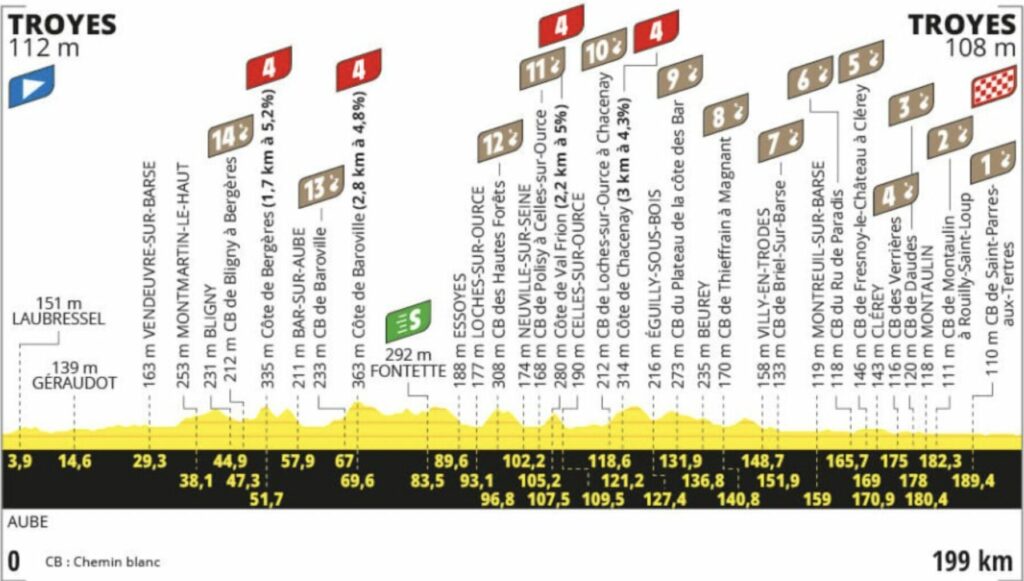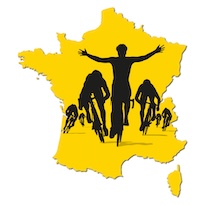This is a challenging, unique, and fun stage of the Tour de France, featuring gravel roads, or “chemins blancs,” included for the first time in the race’s history.
After examining the route of this year’s Tour de France, I knew I wanted to lead this particular stage in my classes because of its uniqueness, but I decided to wait until the stage actually took place. This way, I could accurately describe the events instead of speculating beforehand. As I mentioned in this post about creating Tour de France stages for your classes, this approach means you’ll lead the stage after it occurs. Your riders will have such a great time on this fun but chaotic stage that they won’t mind—and most won’t even realize it! I plan to bring this ride back in the winter when my classes are fuller and we need an exciting, energetic challenge.

Stage 9 is 199 km long and begins and ends in the charming, small city of Troyes, winding through the breathtaking rolling hills of the Champagne region of France. With 76% of the route ascending or descending, and the last 45 km mostly flat, this stage is designed for excitement! Due to the unique route of this year’s Tour de France, starting in Italy and ending in Nice because of the Olympics in Paris, course designers found themselves with many flat stages in a row in the middle of the Tour. To keep viewers engaged and riders challenged, they decided to throw in an added twist: gravel roads.
This stage features the famous chemins blancs, or white roads, of the Champagne countryside. These narrow gravel roads meander through the renowned vineyards, creating a picturesque yet grueling experience. Gravel is commonly seen in the Giro d’Italia, and there’s even a one-day spring classic race in Italy called Le Strade Bianche (White Roads). Current yellow jersey holder Tadej Pogacar, who has raced Le Strade Bianche five times (winning it this year), comes to this race with an advantage. Similar to the cobblestoned roads of the Paris–Roubaix, these gravel segments promise to be equally, if not more, challenging.
Not all riders are pleased with the inclusion of gravel, with some expressing frustration at the added risk. However, a few, like young Remco Evenepoel (the current white jersey holder, or best young rider) and gravel specialist Mathieu van der Poel, are excited for the challenge. This stage includes 33 km of gravel spread over 14 segments, most of which are 1–3 km long, with two segments around 4 km. The first gravel sector appears at 44 km, and the final one ends just 6 km before the finish in Troyes. The gravel segments come thick and fast toward the end, with short pavement breaks in between.
Riders will face dusty roads, rolling hills, and four short but steep category 4 climbs. Mechanical issues and punctures are a real threat today. The route makes a full circle around Troyes, so wind will also be a factor, buffeting the riders from every direction. Luckily, it didn’t rain on the day, avoiding a potentially dangerous mudfest on the gravel.
Three of the songs in this playlist mention champagne to celebrate the famous region you are riding through. One of them, “Champagne Problems” by Meghan Trainor, provides a storyline for the ride that you can ask your class—what kinds of problems exist on this stage through the Champagne countryside?!
Before teaching this ride, if you haven’t seen the stage, it would be helpful to at least watch the highlights. For an in-depth analysis of the race, read this summary by roadcycling.com or this play-by-play by cyclingnews.com.
I’ve provided two versions of this profile. First is the long-form profile with an extensive description and a lot more cueing. The second is the Express Profile (spreadsheet). Usually, however, I try to make the Express Profiles shorter, so they are easier to teach from, but I wanted to include more of the cueing for your convenience. What I recommend is that you download the Excel version or make a copy of the Google Sheet and modify the cueing, adding or subtracting so that it’s easiest for you to teach from. You also may want to change up some of the songs or shorten the ride if you have less than a one-hour time slot.
As usual, I would love to know how your riders enjoyed this ride. Did you modify anything? Change any of the songs? Let me know in the comments!
Even when the Tour de France is over, pull this ride out for an exciting tour around the Champagne countryside!

